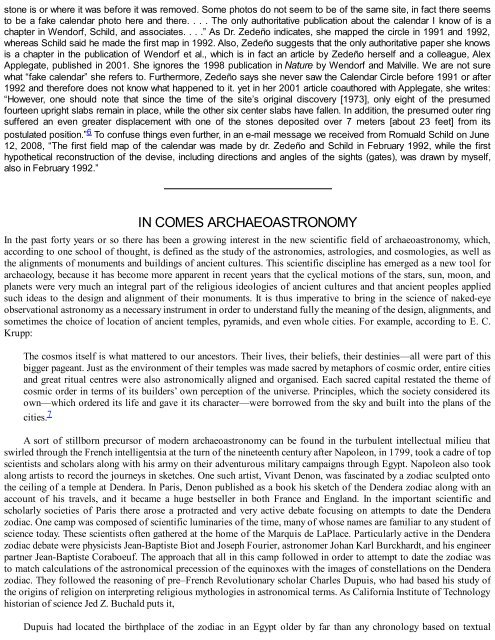Black Genesis: The Prehistoric Origins of Ancient Egypt
Black Genesis: The Prehistoric Origins of Ancient Egypt
Black Genesis: The Prehistoric Origins of Ancient Egypt
Create successful ePaper yourself
Turn your PDF publications into a flip-book with our unique Google optimized e-Paper software.
stone is or where it was before it was removed. Some photos do not seem to be <strong>of</strong> the same site, in fact there seems<br />
to be a fake calendar photo here and there. . . . <strong>The</strong> only authoritative publication about the calendar I know <strong>of</strong> is a<br />
chapter in Wendorf, Schild, and associates. . . .” As Dr. Zedeño indicates, she mapped the circle in 1991 and 1992,<br />
whereas Schild said he made the first map in 1992. Also, Zedeño suggests that the only authoritative paper she knows<br />
is a chapter in the publication <strong>of</strong> Wendorf et al., which is in fact an article by Zedeño herself and a colleague, Alex<br />
Applegate, published in 2001. She ignores the 1998 publication in Nature by Wendorf and Malville. We are not sure<br />
what “fake calendar” she refers to. Furthermore, Zedeño says she never saw the Calendar Circle before 1991 or after<br />
1992 and therefore does not know what happened to it. yet in her 2001 article coauthored with Applegate, she writes:<br />
“However, one should note that since the time <strong>of</strong> the site’s original discovery [1973], only eight <strong>of</strong> the presumed<br />
fourteen upright slabs remain in place, while the other six center slabs have fallen. In addition, the presumed outer ring<br />
suffered an even greater displacement with one <strong>of</strong> the stones deposited over 7 meters [about 23 feet] from its<br />
postulated position.” 6 To confuse things even further, in an e-mail message we received from Romuald Schild on June<br />
12, 2008, “<strong>The</strong> first field map <strong>of</strong> the calendar was made by dr. Zedeño and Schild in February 1992, while the first<br />
hypothetical reconstruction <strong>of</strong> the devise, including directions and angles <strong>of</strong> the sights (gates), was drawn by myself,<br />
also in February 1992.”<br />
IN COMES ARCHAEOASTRONOMY<br />
In the past forty years or so there has been a growing interest in the new scientific field <strong>of</strong> archaeoastronomy, which,<br />
according to one school <strong>of</strong> thought, is defined as the study <strong>of</strong> the astronomies, astrologies, and cosmologies, as well as<br />
the alignments <strong>of</strong> monuments and buildings <strong>of</strong> ancient cultures. This scientific discipline has emerged as a new tool for<br />
archaeology, because it has become more apparent in recent years that the cyclical motions <strong>of</strong> the stars, sun, moon, and<br />
planets were very much an integral part <strong>of</strong> the religious ideologies <strong>of</strong> ancient cultures and that ancient peoples applied<br />
such ideas to the design and alignment <strong>of</strong> their monuments. It is thus imperative to bring in the science <strong>of</strong> naked-eye<br />
observational astronomy as a necessary instrument in order to understand fully the meaning <strong>of</strong> the design, alignments, and<br />
sometimes the choice <strong>of</strong> location <strong>of</strong> ancient temples, pyramids, and even whole cities. For example, according to E. C.<br />
Krupp:<br />
<strong>The</strong> cosmos itself is what mattered to our ancestors. <strong>The</strong>ir lives, their beliefs, their destinies—all were part <strong>of</strong> this<br />
bigger pageant. Just as the environment <strong>of</strong> their temples was made sacred by metaphors <strong>of</strong> cosmic order, entire cities<br />
and great ritual centres were also astronomically aligned and organised. Each sacred capital restated the theme <strong>of</strong><br />
cosmic order in terms <strong>of</strong> its builders’ own perception <strong>of</strong> the universe. Principles, which the society considered its<br />
own—which ordered its life and gave it its character—were borrowed from the sky and built into the plans <strong>of</strong> the<br />
cities. 7<br />
A sort <strong>of</strong> stillborn precursor <strong>of</strong> modern archaeoastronomy can be found in the turbulent intellectual milieu that<br />
swirled through the French intelligentsia at the turn <strong>of</strong> the nineteenth century after Napoleon, in 1799, took a cadre <strong>of</strong> top<br />
scientists and scholars along with his army on their adventurous military campaigns through <strong>Egypt</strong>. Napoleon also took<br />
along artists to record the journeys in sketches. One such artist, Vivant Denon, was fascinated by a zodiac sculpted onto<br />
the ceiling <strong>of</strong> a temple at Dendera. In Paris, Denon published as a book his sketch <strong>of</strong> the Dendera zodiac along with an<br />
account <strong>of</strong> his travels, and it became a huge bestseller in both France and England. In the important scientific and<br />
scholarly societies <strong>of</strong> Paris there arose a protracted and very active debate focusing on attempts to date the Dendera<br />
zodiac. One camp was composed <strong>of</strong> scientific luminaries <strong>of</strong> the time, many <strong>of</strong> whose names are familiar to any student <strong>of</strong><br />
science today. <strong>The</strong>se scientists <strong>of</strong>ten gathered at the home <strong>of</strong> the Marquis de LaPlace. Particularly active in the Dendera<br />
zodiac debate were physicists Jean-Baptiste Biot and Joseph Fourier, astronomer Johan Karl Burckhardt, and his engineer<br />
partner Jean-Baptiste Coraboeuf. <strong>The</strong> approach that all in this camp followed in order to attempt to date the zodiac was<br />
to match calculations <strong>of</strong> the astronomical precession <strong>of</strong> the equinoxes with the images <strong>of</strong> constellations on the Dendera<br />
zodiac. <strong>The</strong>y followed the reasoning <strong>of</strong> pre–French Revolutionary scholar Charles Dupuis, who had based his study <strong>of</strong><br />
the origins <strong>of</strong> religion on interpreting religious mythologies in astronomical terms. As California Institute <strong>of</strong> Technology<br />
historian <strong>of</strong> science Jed Z. Buchald puts it,<br />
Dupuis had located the birthplace <strong>of</strong> the zodiac in an <strong>Egypt</strong> older by far than any chronology based on textual


